Monitoring the Dynamic Response of a Buried Polyethylene Pipe to a Blast Wave: An Experimental Study
Abstract
:1. Introduction
2. The Experimental Setup
2.1. PE Pipe Parameters
2.2. Experimental Site and Pipe
2.3. Strain Gages and Strain Indicator
2.4. Velocity Sensor and Blasting Vibration Meter
3. Experimental Procedure
4. Strain Results and Analysis
4.1. Dimensional Analysis
4.1.1. Load Acting on the Pipe
4.1.2. The Maximum Strain of the Pipeline
4.2. Strain Analysis
4.2.1. The Test Data of the Peak Strain
4.2.2. Peak Strain Attenuation Law
4.2.3. Influence of Waveform Conversion
4.2.4. Dynamic Strain Spectrum Analysis
5. Vibration Velocity Results and Analysis
5.1. GPPV and Pipe Peak Vibration Velocity (PPVV)
5.2. Velocity Spectrum
5.3. Correlation Analysis
6. Blasting Criterion for PE Pipe
6.1. Stress–Strain Constitutive Relation
6.2. Blasting Criterion Establishment
6.3. Engineering Design and Safety Monitoring
7. Conclusions and Future Work
- When the scaled distance is in the range of 4–11, the PCS is generally larger than the PAS at the same test point. The hoop stress level is related to the pipe–soil relative stiffness and the mechanical properties of the material. The shape of the circular section of pipe changes and the local deformation characteristics are obvious. As the scaled distance increases, the blast wave transforms from a compression wave to a seismic wave. The difference between the PHS and PAS value decreases progressively, the local deformation effect steadily weakens, and the overall deformation effect is relatively enhanced and gradually begins to dominate [35]. Therefore, the hoop stress should be fully considered in the safety check in the near and middle field of the blast wave.
- The peak strain and scaled distance have a good power attenuation relationship as demonstrated by dimensional analysis and experimental data analysis.
- According to the strain and velocity spectrum analysis, all of the average frequency is between 10–50 Hz and the vibration frequency is low. The average frequency of strain has a power attenuation relationship with the increase in the charge mass. Additionally, the average frequency of velocity is attenuated with the increase in the scaled distance, and inversely proportional with the blasting cavity factor.
- There was a strong linear correlation between the peak strain, PPVV, and GPPV in this experiment. Thus, we determined that GPPV can directly and effectively reflect the stress level. Moreover GPPV monitoring has the advantages of simple operation, reliable testing, and so on. Therefore, GPPV monitoring should be adopted and promoted as a technical means of on-site monitoring of buried pipelines.
- A single velocity criterion does not reflect the complex influence of various factors, such as pipe type, pipe material, soil properties, blasting source, and so on. Therefore, it is more reasonable to adopt 10% MRS of PE pipe as the blasting criterion. This criterion is accurate and easy to calculate.
Author Contributions
Funding
Acknowledgments
Conflicts of Interest
References
- Kong, Q.; Fan, S.; Bai, X.; Mo, Y.L.; Song, G. A novel embeddable spherical smart aggregate for structural health monitoring: Part I. Fabrication and electrical characterization. Smart Mater. Struct. 2017, 26, 095050. [Google Scholar] [CrossRef]
- Kong, Q.; Fan, S.; Mo, Y.L.; Song, G. A novel embeddable spherical smart aggregate for structural health monitoring: Part II. Numerical and experimental verifications. Smart Mater. Struct. 2017, 26, 095051. [Google Scholar] [CrossRef]
- Song, G.; Wang, C.; Wang, B. Structural health monitoring (SHM) of civil structures. Appl. Sci. 2017, 7, 789. [Google Scholar] [CrossRef]
- Tomonori, N.; Spencer, B.F.; Agha, G.A.; Mechitov, K.A. Model-based data aggregation for structural monitoring employing smart sensors. In Proceedings of the 3rd International Conference on Networked Sensing Systems 2006, Chicago, IL, USA, 31 May–2 June 2006; pp. 203–210. [Google Scholar]
- Balageas, D.; Fritzen, C.P.; Güemes, A. Structural Health Monitoring; John Wiley & Sons: New Jersey, NJ, USA, 2006; pp. 85–95. [Google Scholar]
- Yan, S.; Ma, H.; Li, P.; Song, G.; Wu, J. Development and Application of a Structural Health Monitoring System Based on Wireless Smart Aggregates. Sensors 2017, 17, 1641. [Google Scholar] [CrossRef]
- Hu, X.; Zhu, H.; Wang, D. A study of concrete slab damage detection based on the electromechanical impedance method. Sensors 2014, 14, 19897–19909. [Google Scholar] [CrossRef]
- Xu, J.; Hao, J.; Li, H.; Luo, M.; Guo, W.; Li, W. Experimental Damage Identification of a Model Reticulated Shell. Appl. Sci. 2017, 7, 362. [Google Scholar] [CrossRef]
- Kong, Q.; Robert, R.H.; Silva, P.; Mo, Y.L. Cyclic crack monitoring of a reinforced concrete column under simulated pseudo-dynamic loading using piezoceramic-based smart aggregates. Appl. Sci. 2016, 6, 341. [Google Scholar] [CrossRef]
- Lu, G.; Li, Y.; Wang, T.; Xiao, H.; Huo, L.; Song, G. A multi-delay-and-sum imaging algorithm for damage detection using piezoceramic transducers. J. Intell. Mater. Syst. Struct. 2016, 28, 1150–1159. [Google Scholar] [CrossRef]
- Luo, M.; Li, W.; Hei, C.; Song, G. Concrete Infill Monitoring in Concrete-Filled FRP Tubes Using a PZT-Based Ultrasonic Time-of-Flight Method. Sensors 2016, 16, 2083. [Google Scholar] [CrossRef]
- Cho, S.; Yun, C.B.; Lynch, J.P.; Zimmerman, A.T.; Spencer, B.F., Jr.; Nagayama, T. Smart wireless sensor technology for structural health monitoring of civil structures. Steel Struct. 2008, 8, 267–275. [Google Scholar]
- Huo, L.; Chen, D.; Liang, Y.; Li, H.; Feng, X.; Song, G. Impedance based bolt pre-load monitoring using piezoceramic smart washer. Smart Mater. Struct. 2017, 26, 057004. [Google Scholar] [CrossRef]
- Zhang, G.; Zhu, J.; Song, Y.; Peng, C.; Song, G. A Time Reversal Based Pipeline Leakage Localization Method with the Adjustable Resolution. IEEE Access. 2018, 6, 26993–27000. [Google Scholar] [CrossRef]
- Zhu, J.; Ren, L.; Ho, S.C.; Jia, Z.; Song, G. Gas pipeline leakage detection based on PZT sensors. Smart Mater. Struct. 2017, 26, 025022. [Google Scholar] [CrossRef]
- Hong, X.; Song, G.; Ruan, J.; Zhang, Z.; Wu, S.; Liu, G. Active monitoring of pipeline tapered thread connection based on time reversal using piezoceramic transducers. Smart Struct. Syst. 2016, 18, 643–662. [Google Scholar] [CrossRef]
- Gao, Y.; Brennan, M.J.; Joseph, P.F. On the effects of reflections on time delay estimation for leak detection in buried plastic water pipes. J. Sound Vib. 2009, 325, 649–663. [Google Scholar] [CrossRef]
- Hunaidi, O.; Chu, W.; Wang, A.; Guan, W. Detecting leaks in plastic pipes. J. Am. Water Works Assoc. 2000, 92, 82. [Google Scholar] [CrossRef]
- Ahadi, M.; Bakhtiar, M.S. Leak detection in water-filled plastic pipes through the application of tuned wavelet transforms to Acoustic Emission signals. Appl. Acoust. 2010, 71, 634–639. [Google Scholar] [CrossRef]
- Xu, K.; Deng, Q.; Cai, L.; Ho, S.; Song, G. Damage Detection of a Concrete Column Subject to Blast Loads Using Embedded Piezoceramic Transducers. Sensors 2018, 18, 1377. [Google Scholar] [CrossRef]
- Qi, B.; Kong, Q.; Qian, H.; Patil, D.; Lim, I.; Li, L.M.; Liu, D.; Song, G. Study of impact damage in PVA-ECC beam under low-velocity impact loading using piezoceramic transducers and PVDF thin-film transducers. Sensors 2018, 18, 671. [Google Scholar] [CrossRef] [PubMed]
- Grant, M.; Stewart, M.G. Probabilistic Risk Assessment for Improvised Explosive Device Attacks That Cause Significant Building Damage. J. Perform. Constr. Facil. 2015, 29, B4014009. [Google Scholar] [CrossRef]
- Zhu, J.; Wang, N.; Ho, S.C.; Song, G. Method for Rapid Impact Localization for Subsea Structures. IEEE Sens. J. 2018, 18, 3554–3563. [Google Scholar] [CrossRef]
- Štoller, J.; Zezulová, E. Use of ultrasound-The ultrasonic pulse velocity method for the diagnosis of protective structures after the load of TNT explosion. In Proceedings of the ICMT, 2017 International Conference, Brno, Czech Republic, 31 May–2 June 2017; pp. 230–235. [Google Scholar]
- Zhang, Z.; Zhao, C.; Zhang, L.; Zhao, M. Experimental investigation of blasting vibration safety criterion on buried pipeline. Blasting 2016, 33, 12–16. [Google Scholar]
- Dai, L.; Zhang, H.; Meng, G.; Zhang, L.; Cui, Y.; Li, J. Risk analysis of blasting operations around in-service oil and gas pipelines. Oil Gas Stor. Transp. 2012, 11, 801–803. [Google Scholar]
- Siskind, D.E.; Stagg, M.S.; Wiegand, J.E.; Schulz, D.L. Surface Mine Blasting near Pressurized Transmission Pipelines; U.S. Department of the Interior Bureau of Mines Ri.: Minneapolis, MN, USA, 1994; pp. 2–3, 22–32.
- Esparza, E.D.; Westine, P.S.; Wenzel, A.B. Pipeline Response to Buried Explosive Detonations; American Gas Association: Arlington, VA, USA, 1981; Volume 2, pp. 146–152, 133–134. [Google Scholar]
- Abedi, A.S.; Hataf, N.; Ghahramani, A. Analytical solution of the dynamic response of buried pipelines under blast wave. Int. J. Rock Mech. Mining Sci. 2016, 88, 301–306. [Google Scholar] [CrossRef]
- Dowding, C.H. Blast Vibration Monitoring and Control; Prentice-Hall: New Jersey, NJ, USA, 1985; pp. 167–171. [Google Scholar]
- Kouretzis, G.P.; Bouckovalas, G.D.; Gantes, C.J. Analytical calculation of blast-induced strains to buried pipelines. Int. J. Impact Eng. 2007, 34, 1683–1704. [Google Scholar] [CrossRef]
- Kutuzov, B.H. Blasting Engineer’s Manual; Liu, Q., Ed.; China Coal Industry Publishing House: Beijing, China, 1992; pp. 137–138. [Google Scholar]
- Triviño, L.F.; Mohanty, B.; Milkereit, B. Seismic waveforms from explosive sources located in boreholes and initiated in different directions. J. Appl. Geophys. 2012, 87, 81–93. [Google Scholar] [CrossRef]
- Lu, W.; Zhang, L.; Zhou, J.; Jin, X.; Chen, M.; Yan, P. Theoretical Analysis on Decay Mechanism and Law of Blasting Vibration Frequency. Blasting 2013, 30, 1–7. [Google Scholar]
- Datta, T.K. Seismic response of buried pipelines: A state-of-the-art review. Nucl. Eng. Des. 1999, 192, 271–284. [Google Scholar] [CrossRef]
- Hu, Y.; Yang, Y. Wave propagation modeling of the PZT sensing region for structural health monitoring. Smart Mater. Struct. 2007, 16, 706–716. [Google Scholar] [CrossRef]
- Lu, G.; Feng, Q.; Li, Y.; Wang, H.; Song, G. Characterization of Ultrasound Energy Diffusion Due to Small-Size Damage on an Aluminum Plate Using Piezoceramic Transducers. Sensors 2017, 17, 2796. [Google Scholar] [CrossRef]
- Wang, F.; Ho, S.C.M.; Huo, L.; Song, G. A Novel Fractal Contact-Electromechanical Impedance Model for Quantitative Monitoring of Bolted Joint Looseness. IEEE Access 2018, 6, 40212–40220. [Google Scholar] [CrossRef]
- Venugopal, V.P.; Wang, G. Modeling and analysis of Lamb wave propagation in a beam under lead zirconate titanate actuation and sensing. J. Intell. Mater. Syst. Struct. 2015, 26, 1679–1698. [Google Scholar] [CrossRef]
- Yao, P.; Kong, Q.; Xu, K.; Jiang, T.; Huo, L.; Song, G. Structural health monitoring of multi-spot welded joints using a lead zirconate titanate based active sensing approach. Smart Mater. Struct. 2016, 25, 015031. [Google Scholar] [CrossRef]
- Agrawal, B.N.; Elshafei, M.A.; Song, G. Adaptive antenna shape control using piezoelectric actuators. Acta Astronaut. 1997, 40, 821–826. [Google Scholar] [CrossRef]
- Wang, F.R.; Huo, L.S.; Song, G. A piezoelectric active sensing method for quantitative monitoring of bolt loosening using energy dissipation caused by tangential damping based on the fractal contact theory. Smart Mater. Struct. 2018, 27, 9. [Google Scholar] [CrossRef]
- Huo, L.; Li, C.; Jiang, T.; Li, H.N. Feasibility Study of Steel Bar Corrosion Monitoring Using a Piezoceramic Transducer Enabled Time Reversal Method. Appl. Sci. 2018, 8, 2304. [Google Scholar] [CrossRef]
- Lu, G.; Li, Y.; Zhou, M.; Feng, Q.; Song, G. Detecting Damage Size and Shape in a Plate Structure Using PZT Transducer Array. J. Aerosp. Eng. 2018, 31, 04018075. [Google Scholar] [CrossRef]
- Huo, L.; Wang, B.; Chen, D.; Song, G. Monitoring of Pre-Load on Rock Bolt Using Piezoceramic-Transducer Enabled Time Reversal Method. Sensors 2017, 17, 2467. [Google Scholar] [CrossRef] [PubMed]
- Xu, B.; Song, G.; Mo, Y.L. Embedded piezoelectric lead-zirconate-titanate-based dynamic internal normal stress sensor for concrete under impact. J. Intell. Mater. Syst. Struct. 2017, 28, 2659–2674. [Google Scholar] [CrossRef]
- Du, G.; Zhang, J.; Zhang, J.; Song, G. Experimental Study on Stress Monitoring of Sand-Filled Steel Tube during Impact Using Piezoceramic Smart Aggregates. Sensors 2017, 17, 1930. [Google Scholar] [CrossRef] [PubMed]
- Song, G.; Olmi, C.; Gu, H. An overheight vehicle–bridge collision monitoring system using piezoelectric transducers. Smart Mater. Struct. 2007, 16, 462–468. [Google Scholar] [CrossRef]
- Du, G.; Kong, Q.; Wu, F.; Ruan, J.; Song, G. An experimental feasibility study of pipeline corrosion pit detection using a piezoceramic time reversal mirror. Smart Mater. Struct. 2016, 25, 037002. [Google Scholar] [CrossRef]
- Feng, Q.; Kong, Q.; Huo, L.; Song, G. Crack detection and leakage monitoring on reinforced concrete pipe. Smart Mater. Struct. 2015, 24, 115020. [Google Scholar] [CrossRef]
- Du, G.; Kong, Q.; Lai, T.; Song, G. Feasibility Study on Crack Detection of Pipelines Using Piezoceramic Transducers. Int. J. Distrib. Sens. Netw. 2013, 9, 631715. [Google Scholar] [CrossRef]
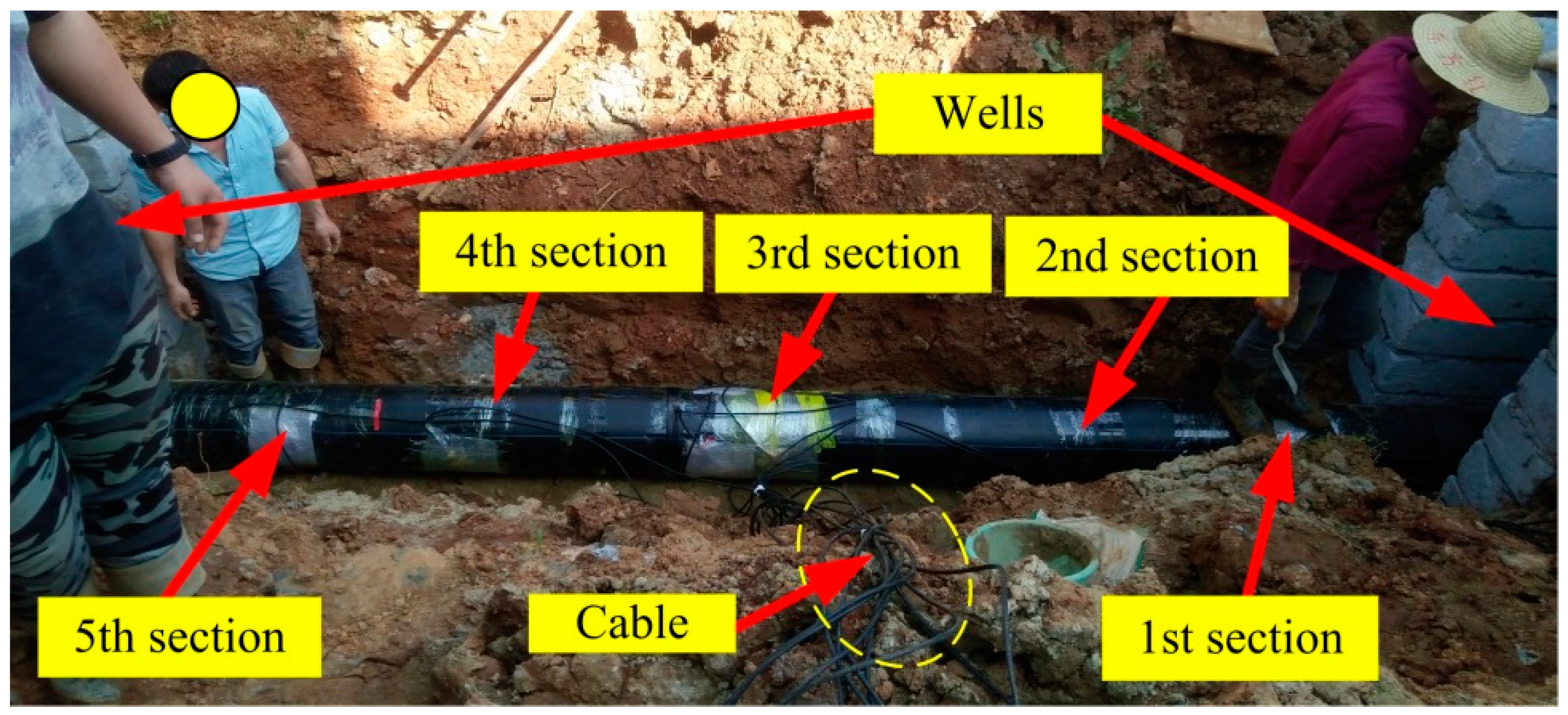
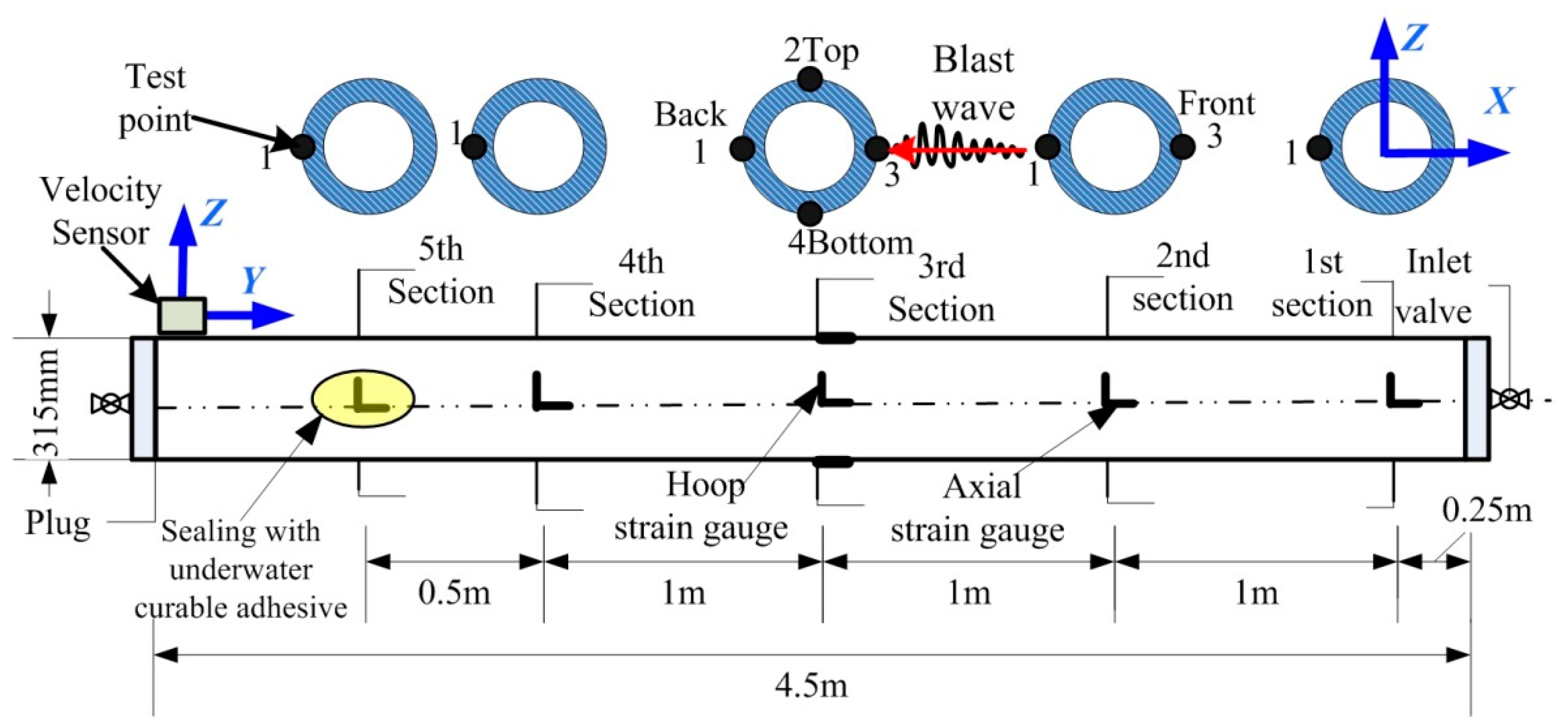
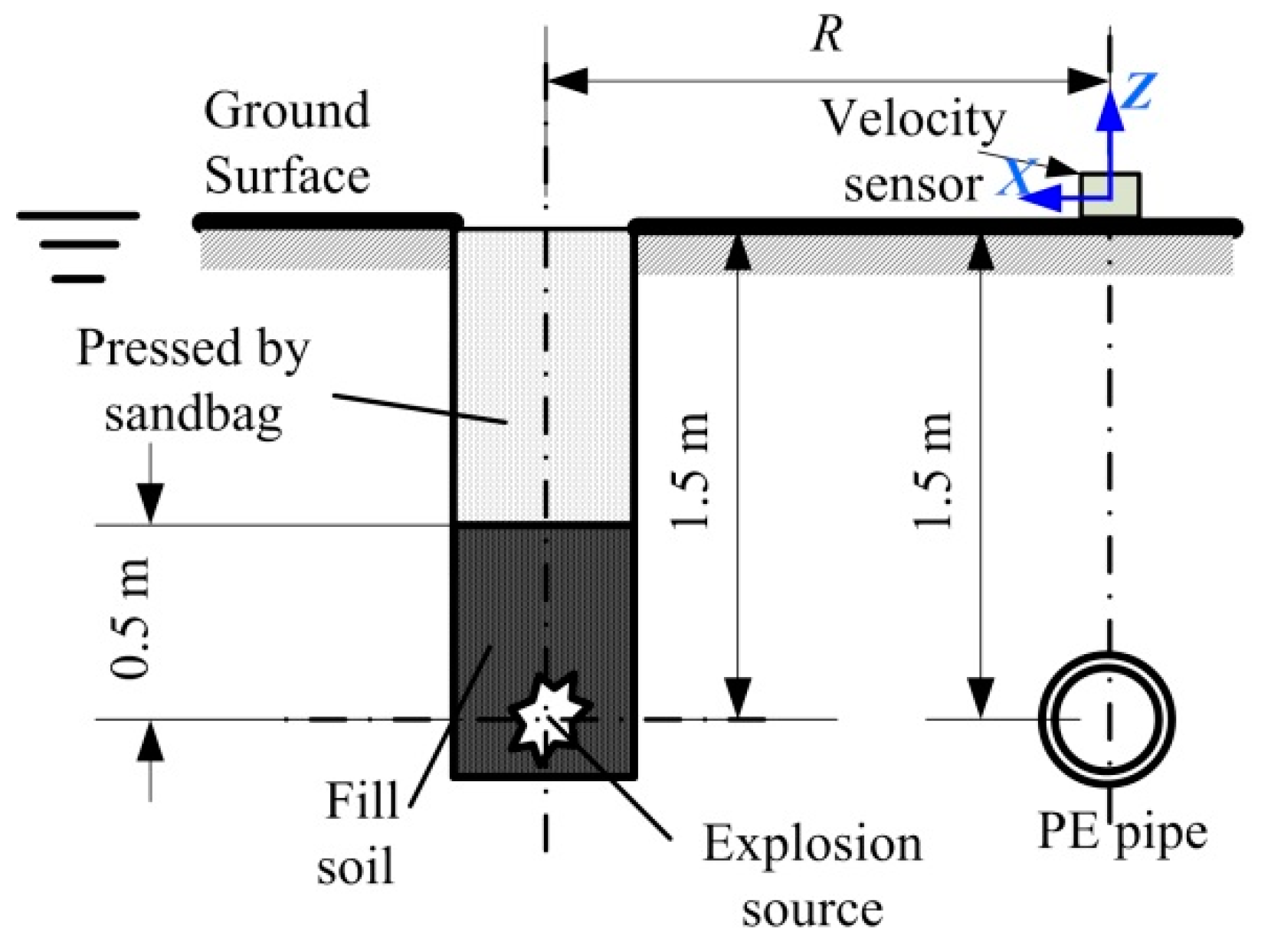
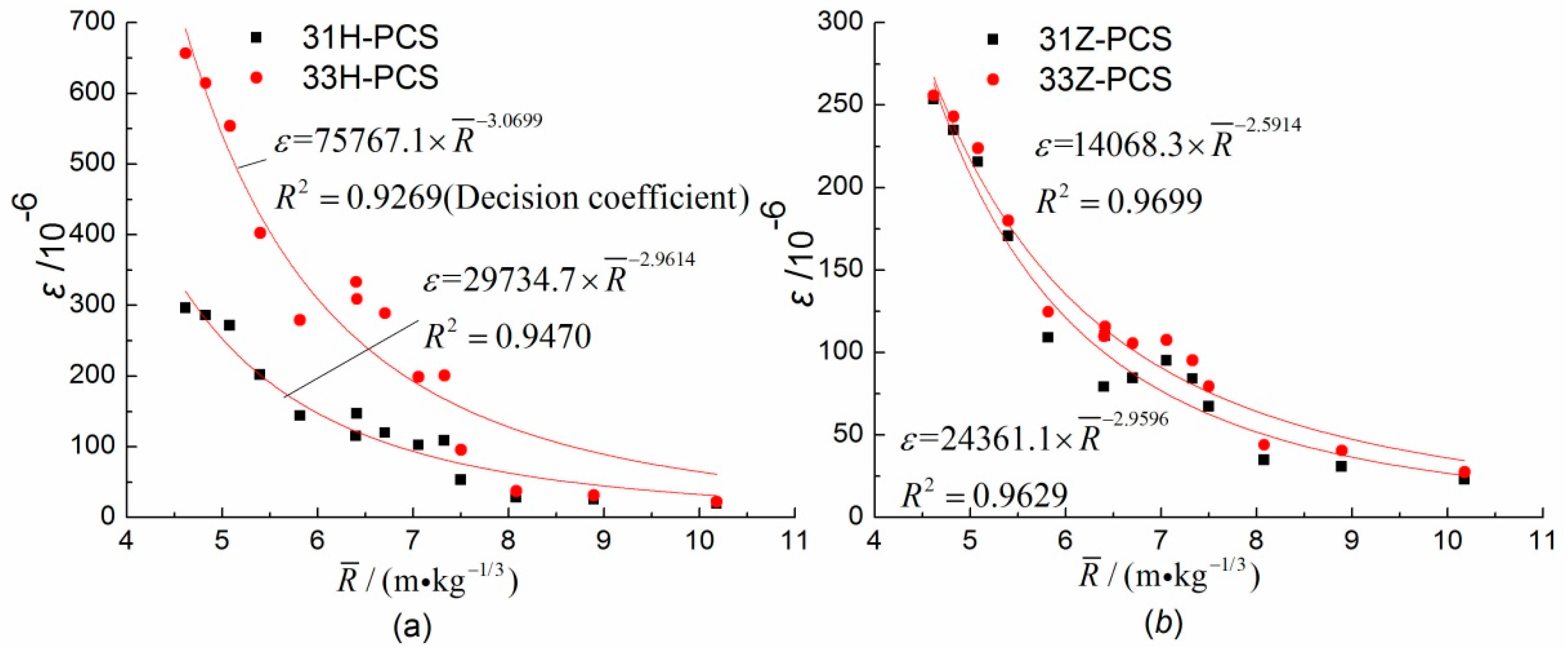
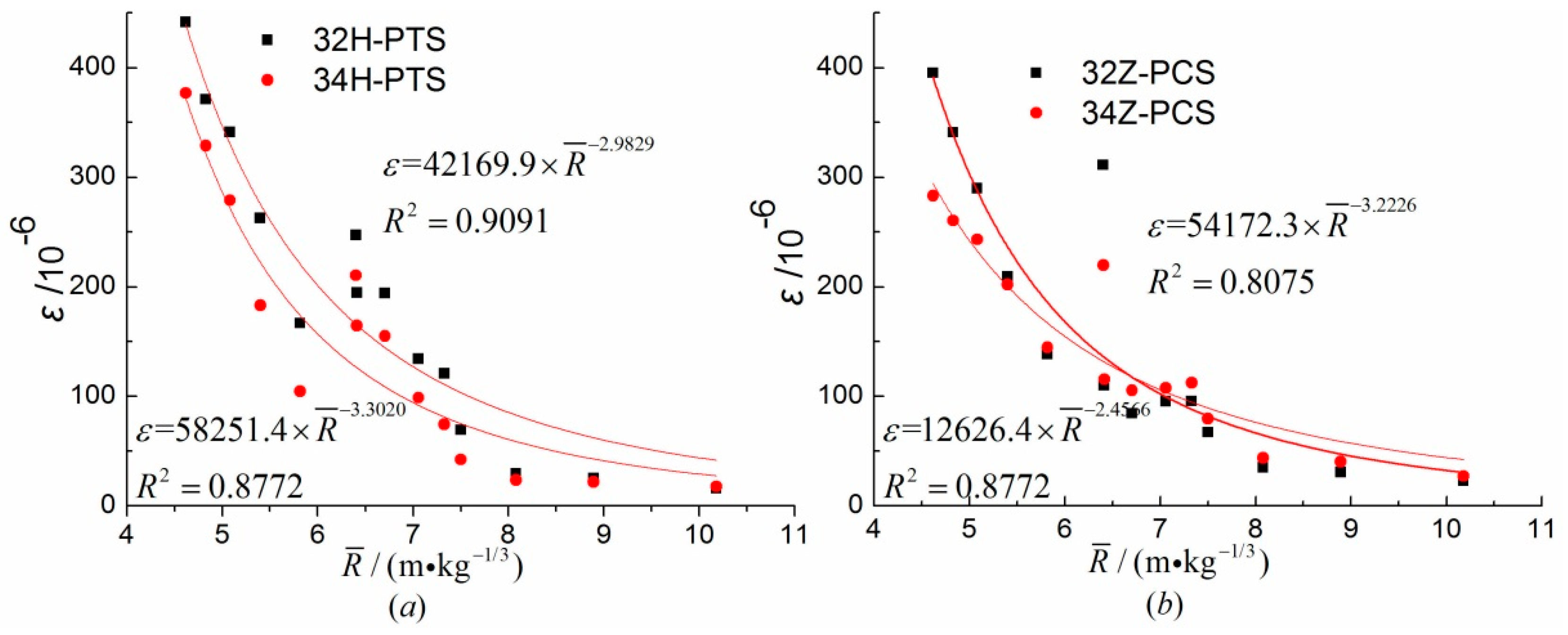
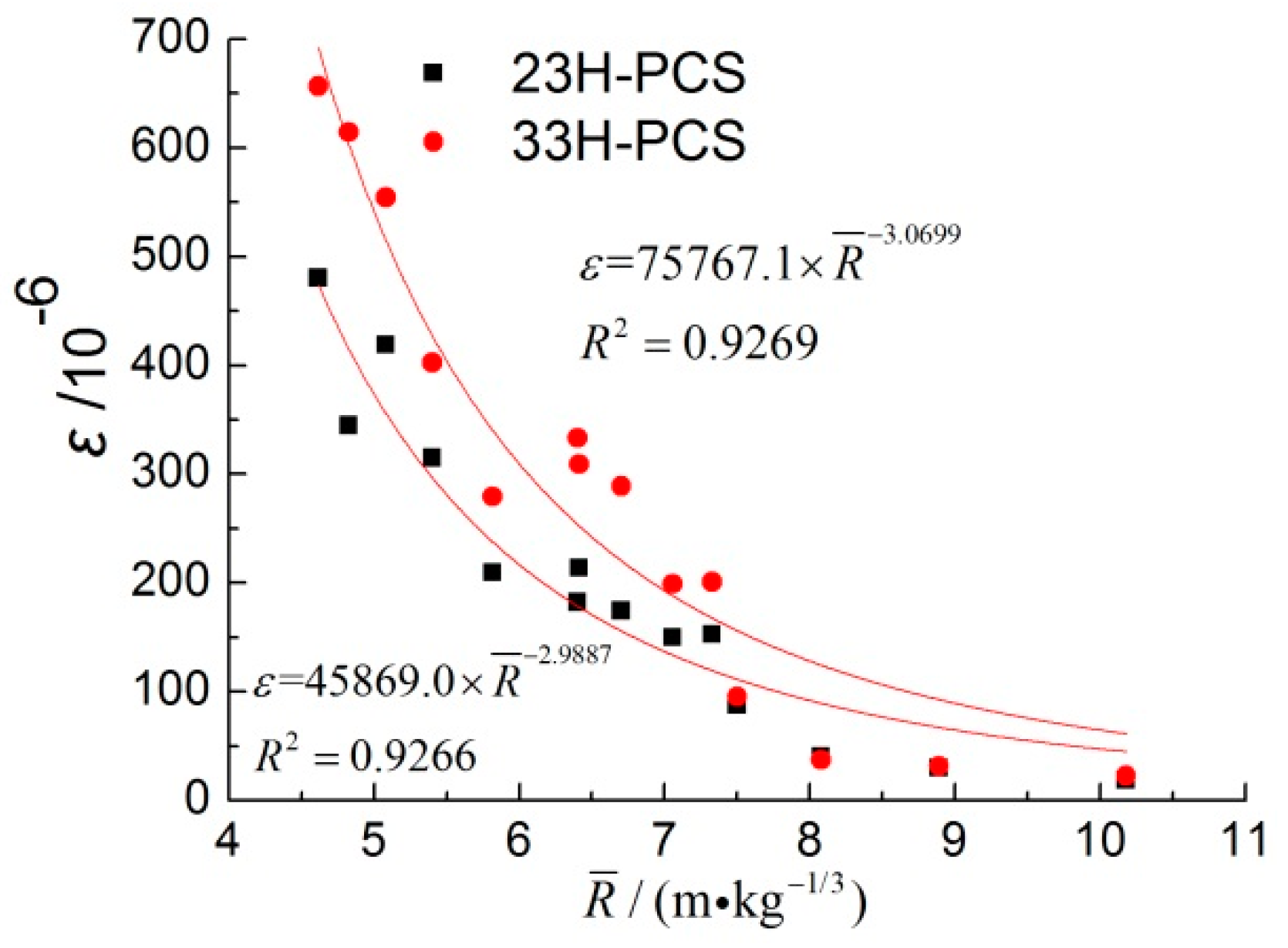
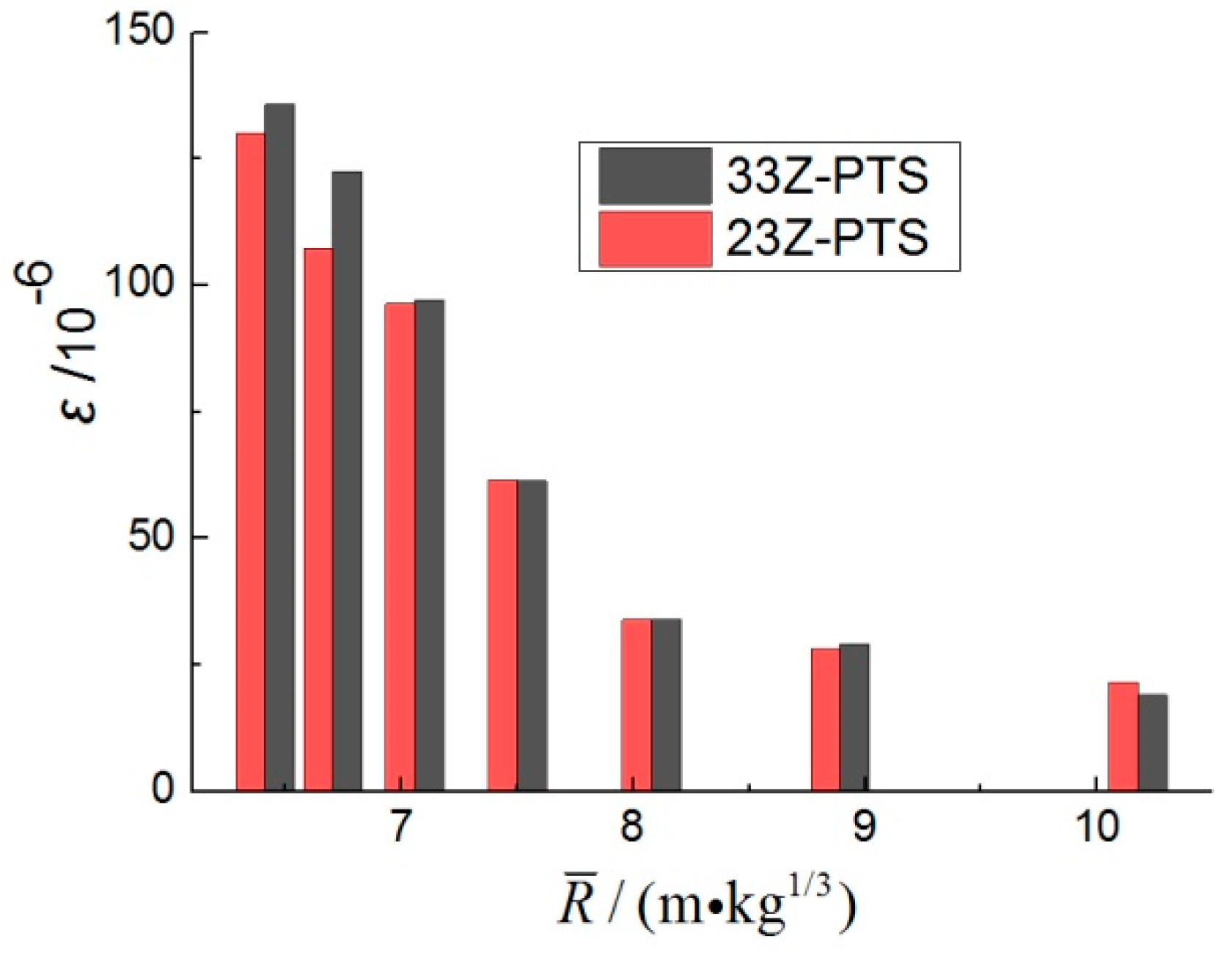
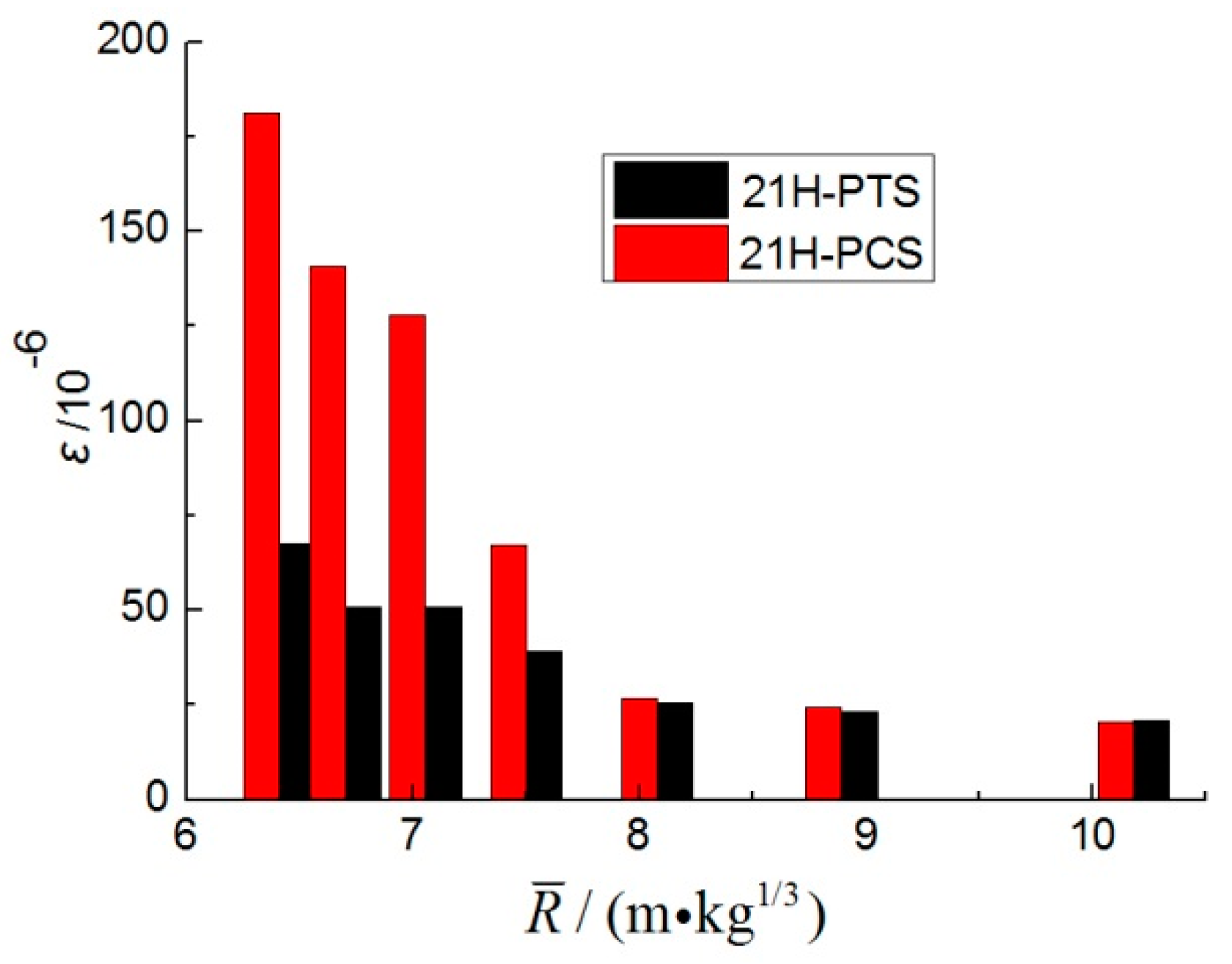
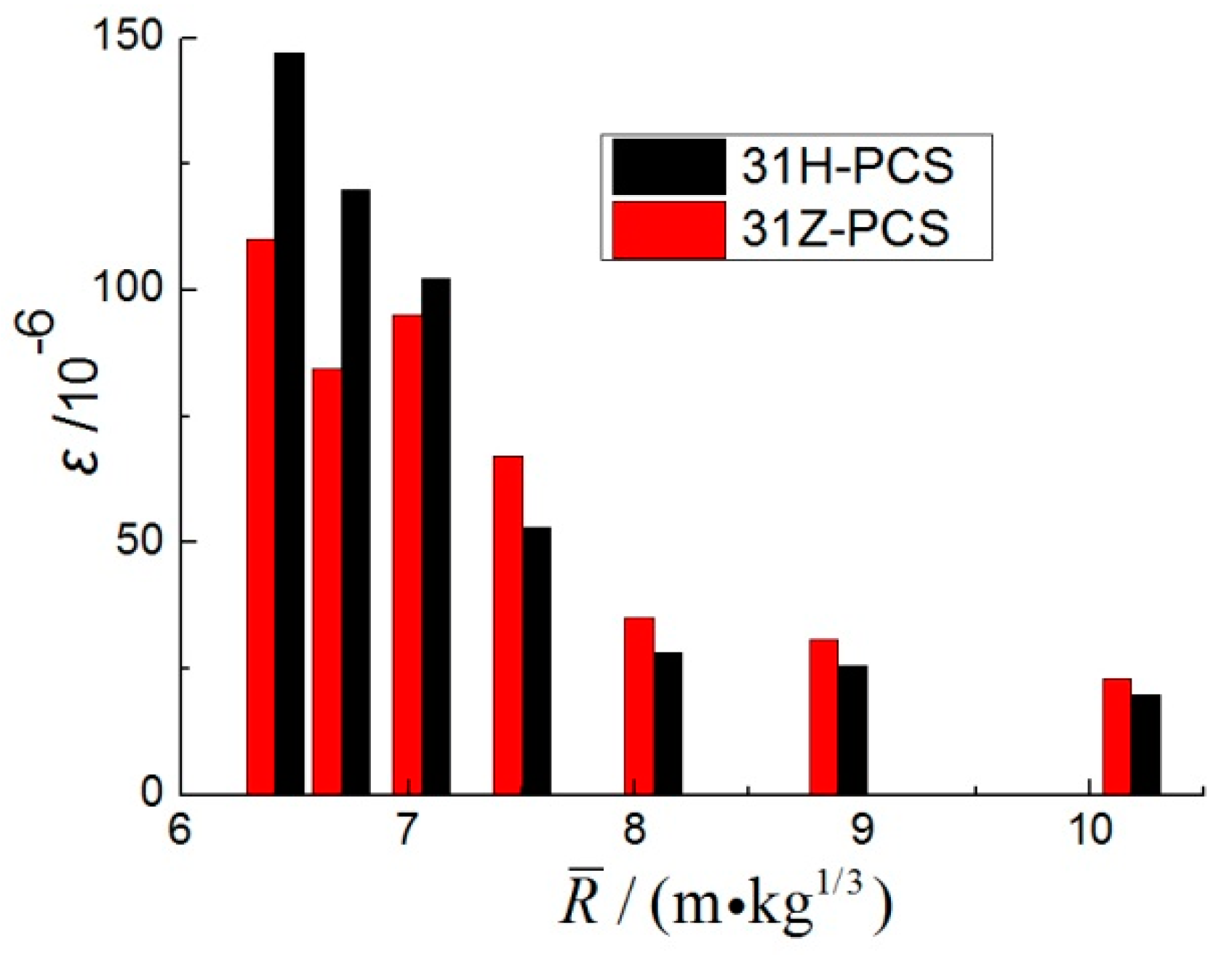
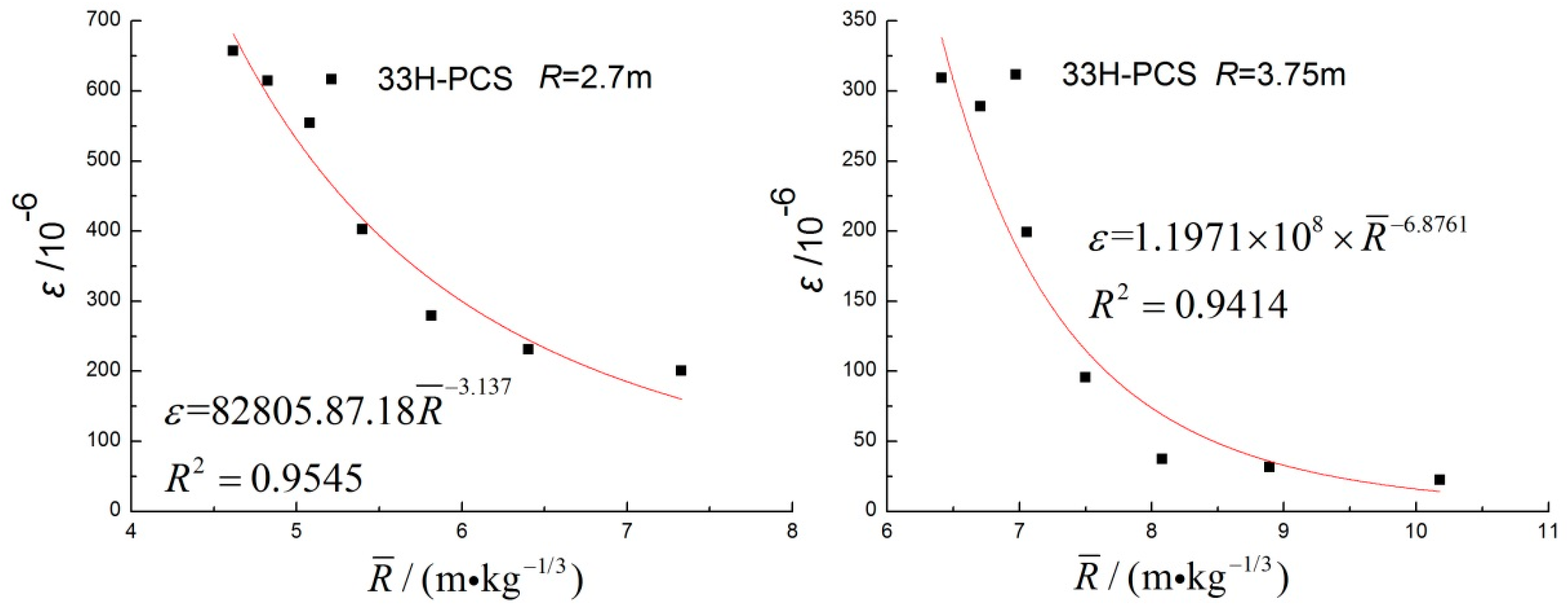
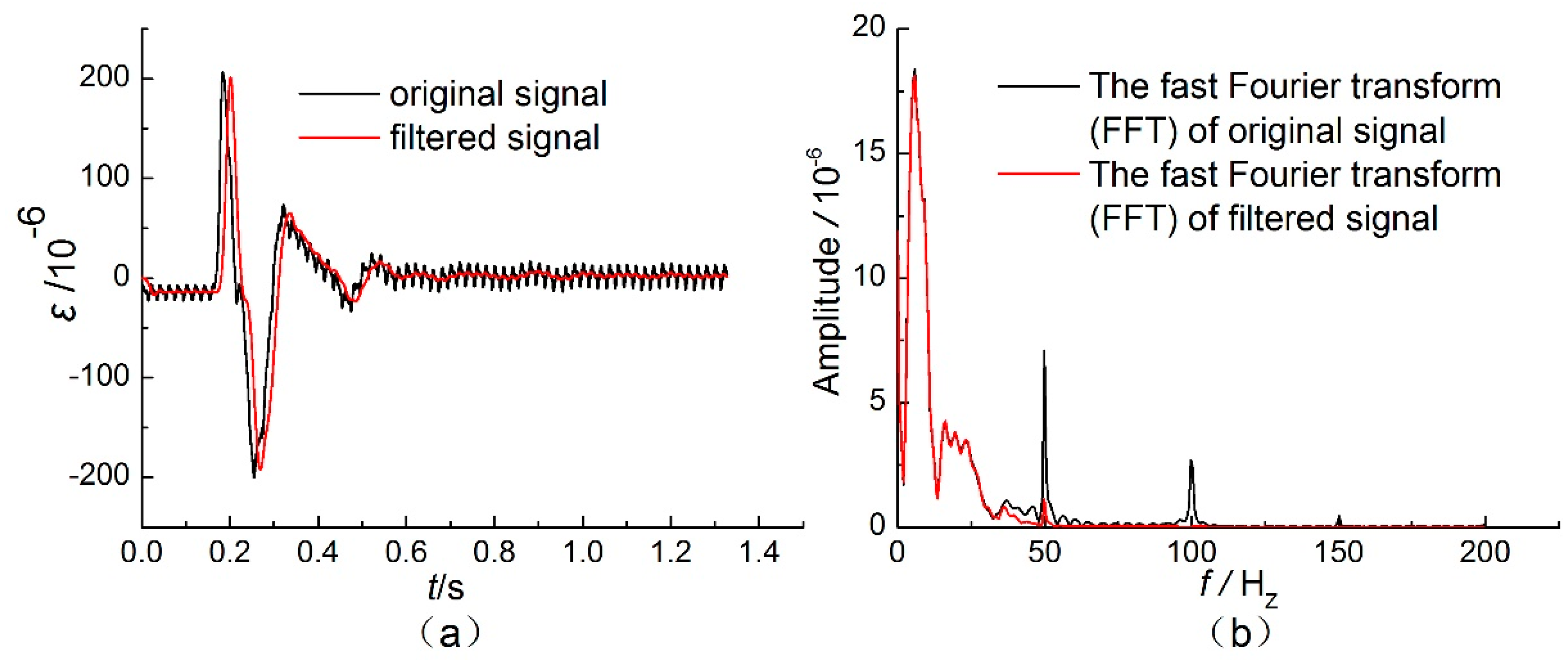


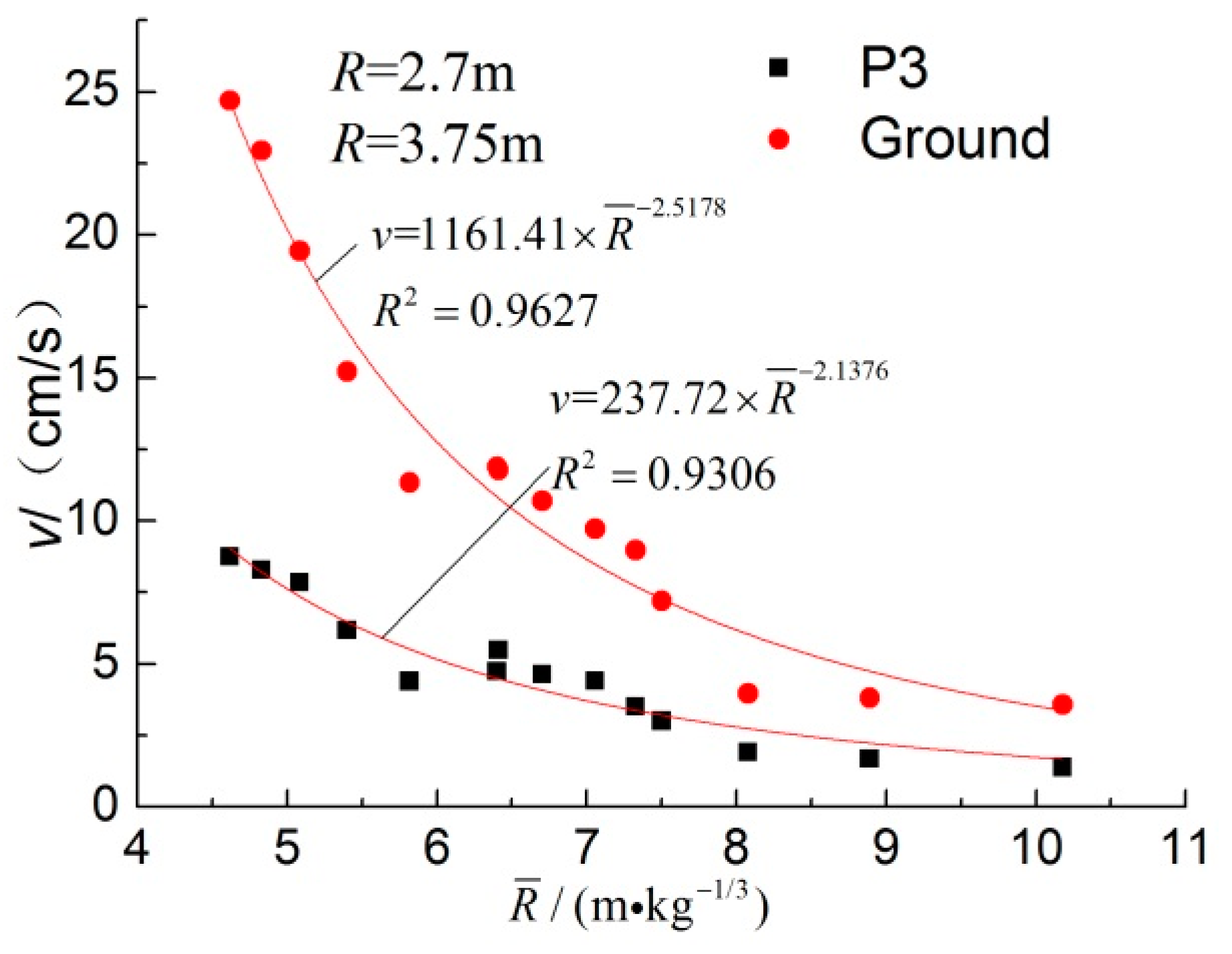
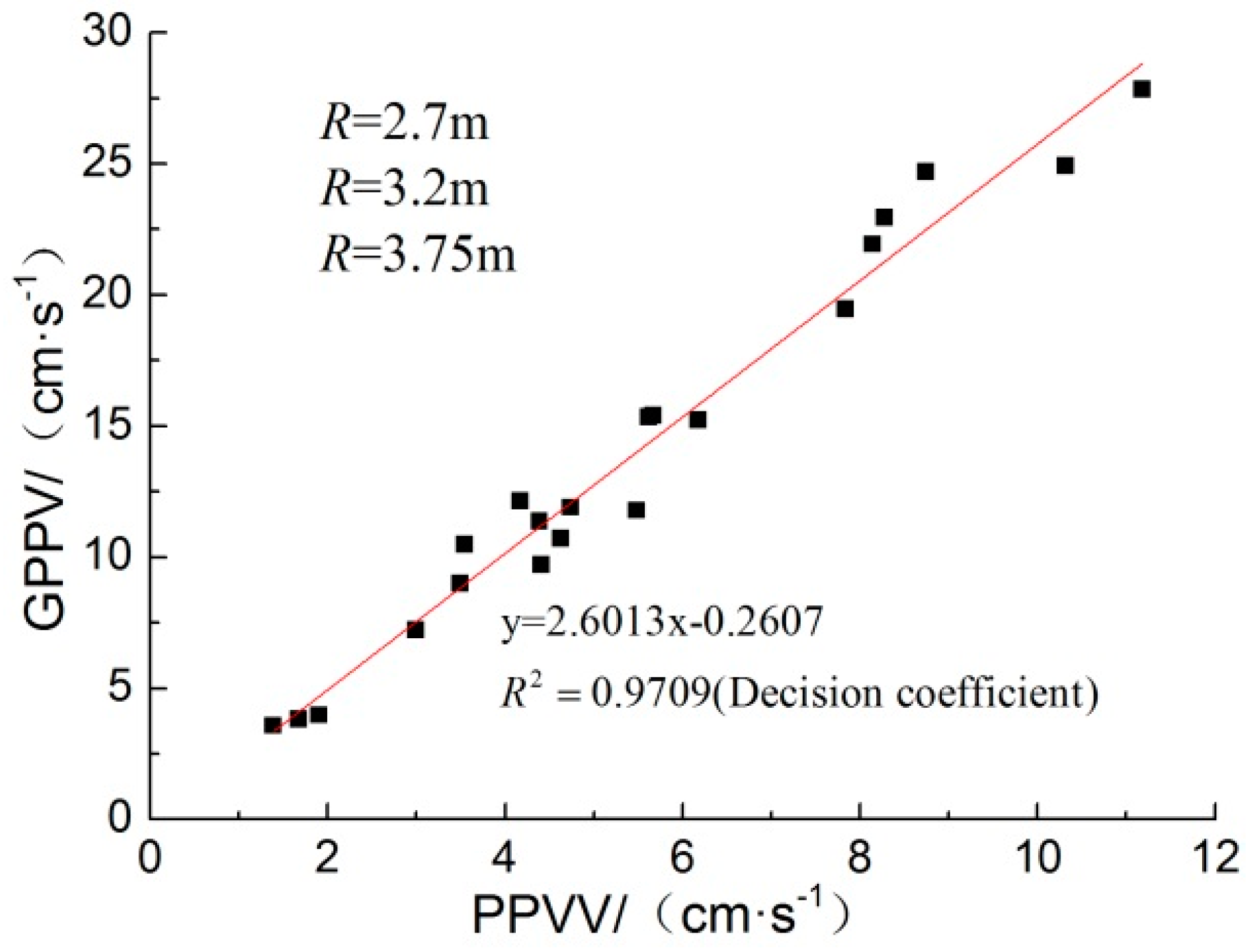
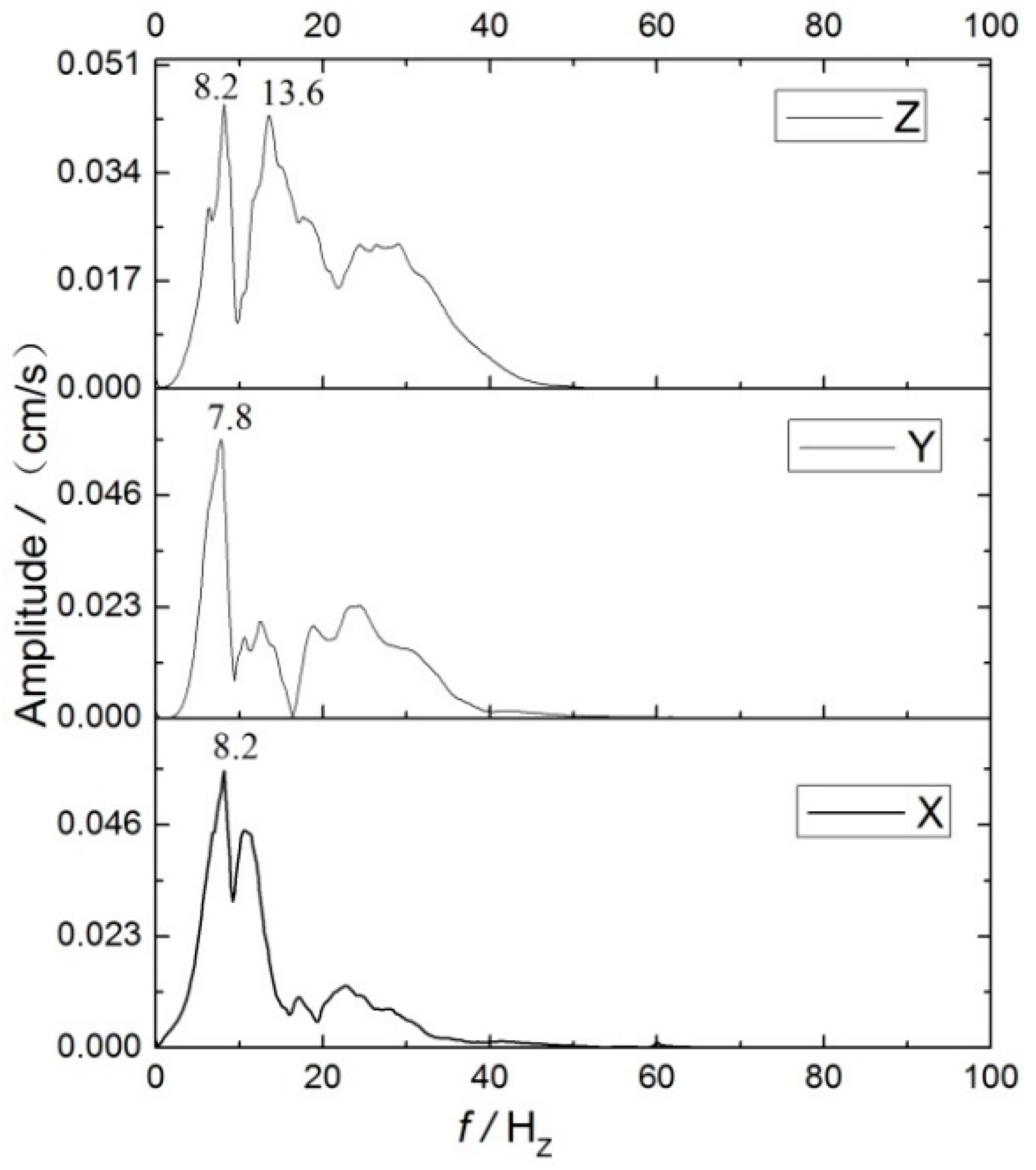
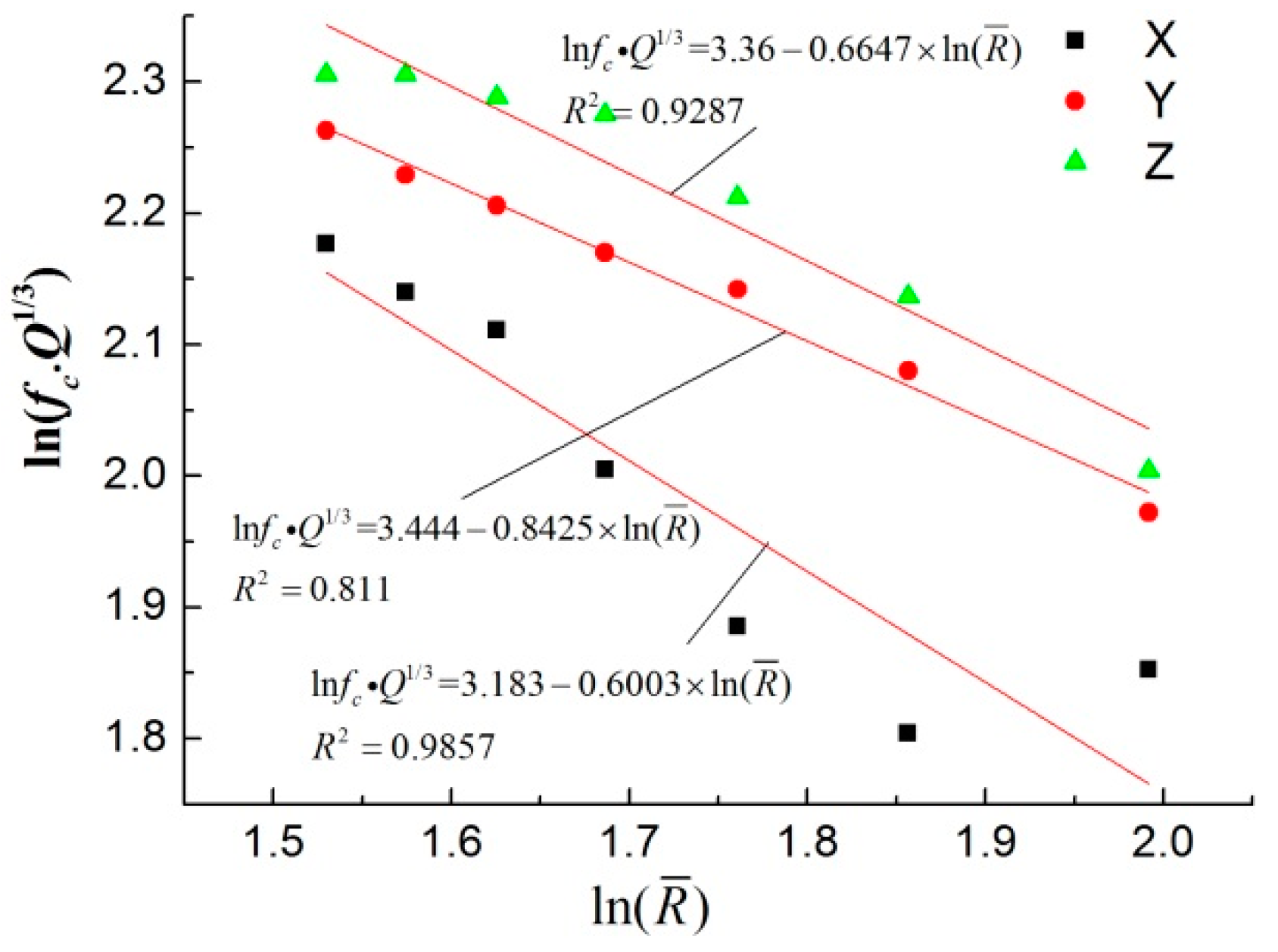
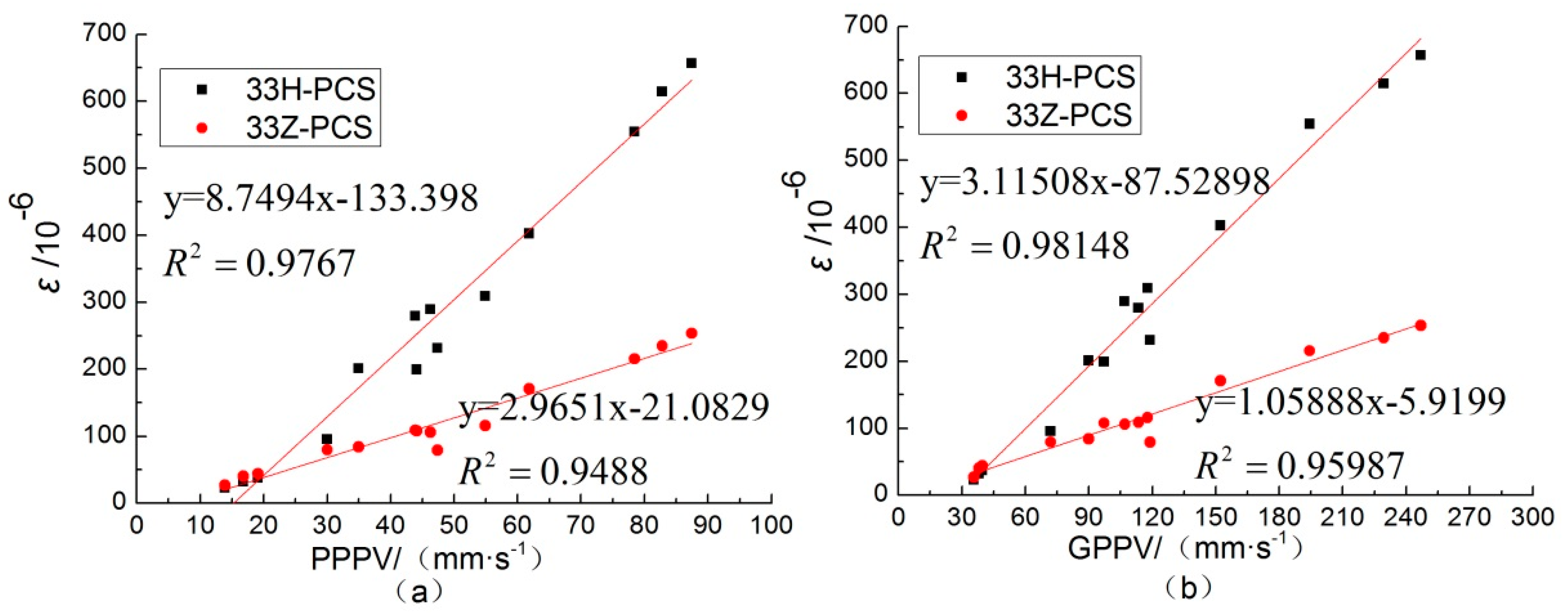
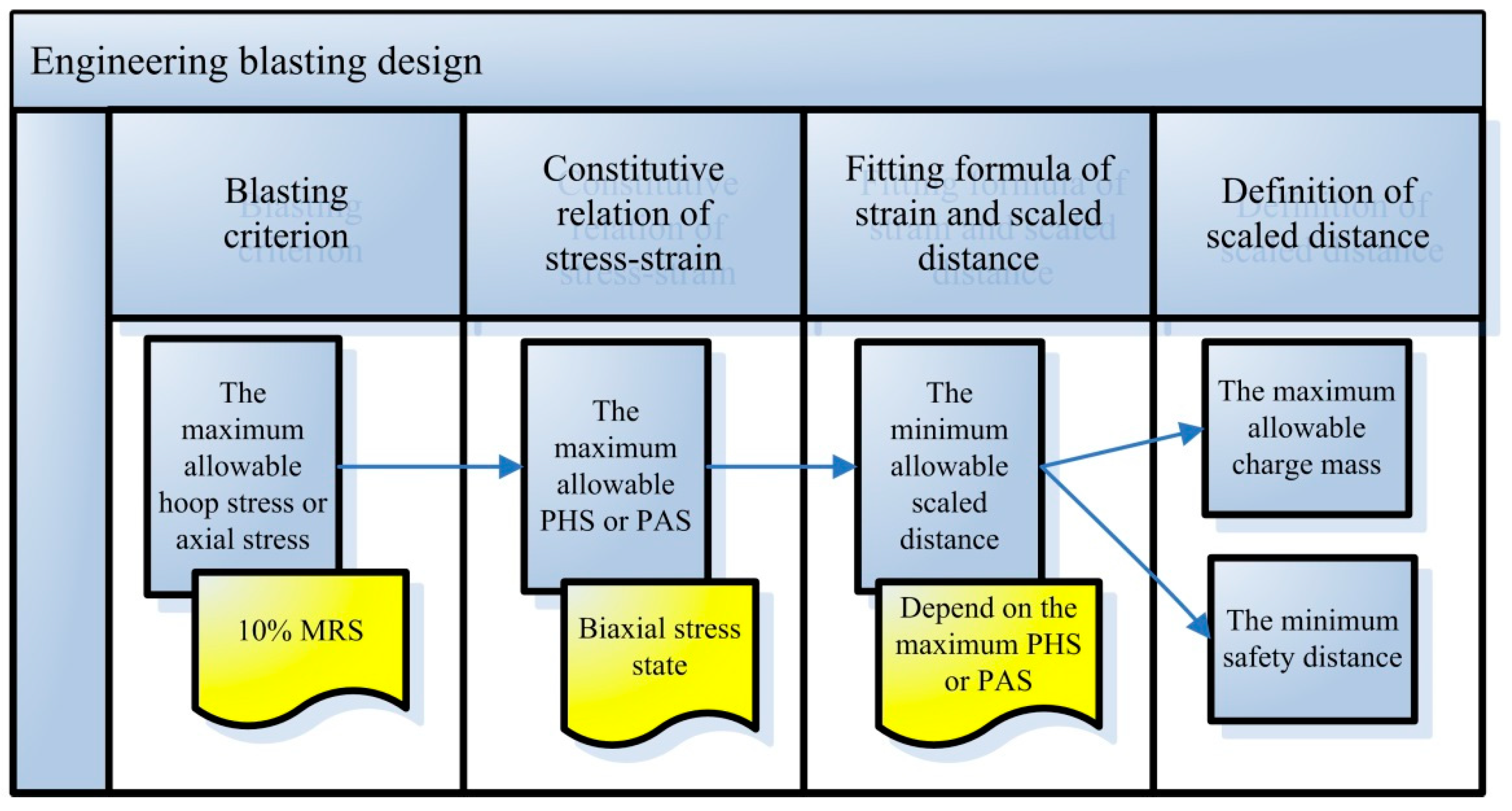
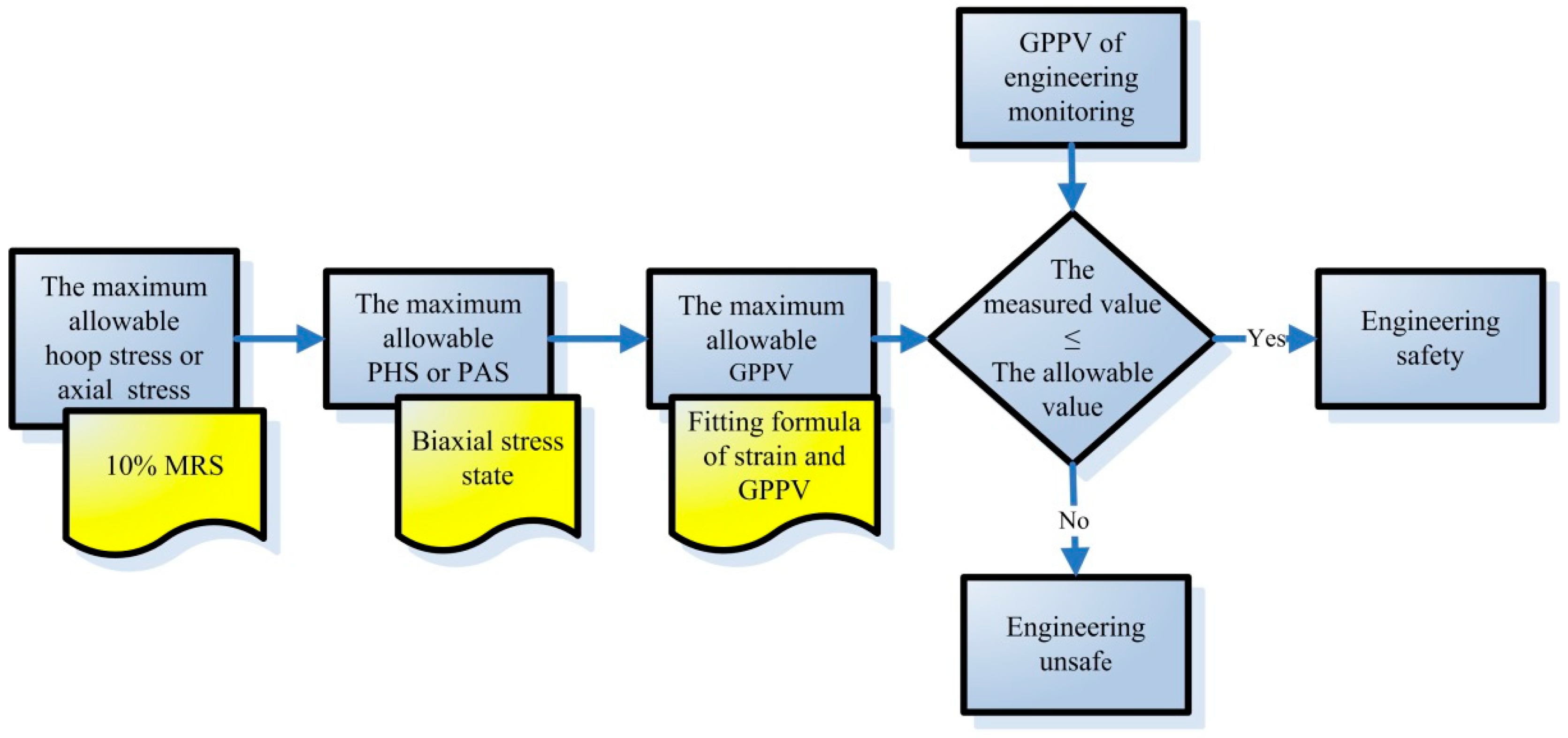
| L (m) | D (mm) | δ (mm) | MRS (MPa) | ρp (kg·m−3) | EP (MPa) | μ | σb (MPa) | ξ% | αs |
|---|---|---|---|---|---|---|---|---|---|
| 4.8 | 314.9 | 18.4 | 8 | 936 | 834.9 | 0.38 | 31.6 | 116 | 0.20 |
| H (m) | R (m) | Q (g) | ||||||
|---|---|---|---|---|---|---|---|---|
| 1.5 | 2.7 | 50 | 75 | 100 | 125 | 150 | 175 | 200 |
| 3.2 | 50 | 75 | 100 | 125 | 150 | 175 | 200 | |
| 3.75 | 50 | 75 | 100 | 125 | 150 | 175 | 200 | |
| Point | The Peak Tensile Strain (PTS) and Peak Compressive Strain (PCS)/10−6 | |||||||||||||
|---|---|---|---|---|---|---|---|---|---|---|---|---|---|---|
| 50 (g) | 75 (g) | 100 (g) | 125 (g) | 150 (g) | 175 (g) | 200 (g) | ||||||||
(m/kg−1/3) | (m/kg−1/3) | (m/kg−1/3) | (m/kg−1/3) | (m/kg−1/3) | (m/kg−1/3) | (m/kg−1/3) | ||||||||
| PTS | PCS | PTS | PCS | PTS | PCS | PTS | PCS | PTS | PCS | PTS | PCS | PTS | PCS | |
| 21H | 46 | 121 | 86 | 151 | 73 | 160 | 99 | 239 | 143 | 318 | 162 | 340 | 182 | 356 |
| 21Z | 42 | 79 | 56 | 116 | 68 | 90 | 71 | 109 | 75 | 119 | 78 | 114 | 76 | 121 |
| 23H | 40 | 153 | 62 | 82 | 65 | 210 | 94 | 315 | 129 | 419 | 115 | 345 | 177 | 480 |
| 23Z | 137 | 103 | 139 | 97 | 141 | 107 | 200 | 154 | 256 | 197 | 178 | 169 | 292 | 232 |
| 31H | 43 | 109 | 56 | 115 | 64 | 144 | 87 | 202 | 122 | 271 | 136 | 286 | 158 | 296 |
| 31Z | 95 | 84 | 62 | 79 | 113 | 109 | 137 | 171 | 159 | 216 | 164 | 235 | 159 | 254 |
| 32H | 121 | 70 | 247 | 247 | 167 | 90 | 263 | 145 | 341 | 259 | 371 | 313 | 442 | 365 |
| 32Z | 83 | 96 | 216 | 311 | 107 | 139 | 131 | 209 | 193 | 290 | 248 | 341 | 296 | 395 |
| 33H | 41 | 201 | 174 | 333 | 91 | 279 | 158 | 403 | 271 | 554 | 333 | 614 | 420 | 657 |
| 33Z | 141 | 95 | 303 | 295 | 192 | 125 | 256 | 180 | 339 | 224 | 370 | 243 | 387 | 256 |
| 34H | 74 | 90 | 211 | 185 | 105 | 97 | 183 | 105 | 279 | 152 | 329 | 202 | 377 | 274 |
| 34Z | 117 | 113 | 171 | 220 | 135 | 145 | 171 | 202 | 215 | 243 | 246 | 260 | 239 | 283 |
| Item | Peak Velocity (mm·s−1) | ||||||
|---|---|---|---|---|---|---|---|
| 50 (g) | 75 (g) | 100 (g) | 125 (g) | 150 (g) | 175 (g) | 200 (g) | |
| PPVV | 35 | 47 | 44 | 62 | 78 | 83 | 87 |
| GPPV | 90 | 119 | 114 | 152 | 194 | 229 | 247 |
| Ratio | 38.9% | 39.9% | 38.7% | 40.6% | 40.3% | 36.1% | 35.4% |
| Blasting Source Distance | MRS | Maximum Allowable Hoop Stress | Maximum Allowable PHS | Minimum Scaled Distance | Allowable Charge Mass | Allowable GPPV |
|---|---|---|---|---|---|---|
| 5 m | 8 MPa | 0.8 MPa | 820 (×10−6) | 2.92 m kg−1/3 | 5.02 kg | 291 mm/s |
© 2019 by the authors. Licensee MDPI, Basel, Switzerland. This article is an open access article distributed under the terms and conditions of the Creative Commons Attribution (CC BY) license (http://creativecommons.org/licenses/by/4.0/).
Share and Cite
Zhong, D.; Gong, X.; Han, F.; Li, L. Monitoring the Dynamic Response of a Buried Polyethylene Pipe to a Blast Wave: An Experimental Study. Appl. Sci. 2019, 9, 1663. https://doi.org/10.3390/app9081663
Zhong D, Gong X, Han F, Li L. Monitoring the Dynamic Response of a Buried Polyethylene Pipe to a Blast Wave: An Experimental Study. Applied Sciences. 2019; 9(8):1663. https://doi.org/10.3390/app9081663
Chicago/Turabian StyleZhong, Dongwang, Xiangchao Gong, Fang Han, and Linna Li. 2019. "Monitoring the Dynamic Response of a Buried Polyethylene Pipe to a Blast Wave: An Experimental Study" Applied Sciences 9, no. 8: 1663. https://doi.org/10.3390/app9081663
APA StyleZhong, D., Gong, X., Han, F., & Li, L. (2019). Monitoring the Dynamic Response of a Buried Polyethylene Pipe to a Blast Wave: An Experimental Study. Applied Sciences, 9(8), 1663. https://doi.org/10.3390/app9081663





